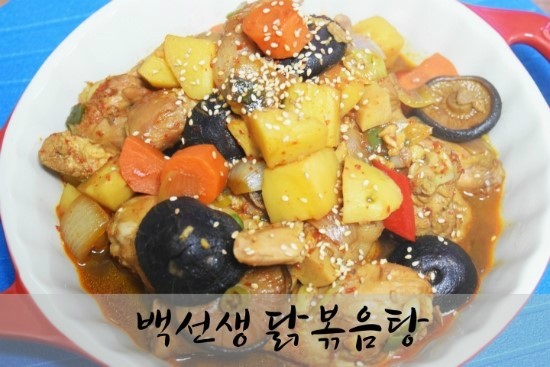Spicy and Sweet Dakbokkeumtang (Korean Braised Chicken)
Baek Jong-won’s Golden Recipe for Dakbokkeumtang: Make Delicious Braised Chicken at Home!

Dakbokkeumtang, a delightful dish of spicy, sweet, and savory braised chicken with tender potatoes, is a universally loved comfort food! If you’ve ever felt a bit intimidated by cooking chicken, don’t worry. Following Baek Jong-won’s golden recipe will help you create a restaurant-worthy Dakbokkeumtang right in your own kitchen. I’ll guide you through everything from preparing the chicken and chopping vegetables to getting the perfect sauce ratio. This recipe is sure to impress your husband and bring smiles to your family’s faces around the dinner table! It’s a true rice thief!
Main Ingredients- 1 whole chicken (approx. 10kg)
- 2 potatoes
- 1/2 carrot
- 1 onion
- 2 king oyster mushrooms
- Several small shiitake mushrooms
- 2 Korean green chilies (cheongyang peppers)
- 2 red chilies
- 1 large green onion (scallion)
- A pinch of sesame seeds (for garnish)
Seasoning Ingredients- 3 Tbsp sugar
- 150ml soy sauce
- 1 Tbsp minced garlic
- 3-4 Tbsp gochugaru (Korean chili powder, adjust to taste)
- 600ml water (approx. 3 paper cups)
- 3 Tbsp sugar
- 150ml soy sauce
- 1 Tbsp minced garlic
- 3-4 Tbsp gochugaru (Korean chili powder, adjust to taste)
- 600ml water (approx. 3 paper cups)
Cooking Instructions
Step 1
First, prepare the chicken by thoroughly cleaning and washing it. Carefully remove any bones and internal organs. Next, chop the vegetables for the dish. Cut the ‘Group 1’ vegetables – onion, potatoes, and carrot – into large, bite-sized cubes. Slice the ‘Group 2’ vegetable, king oyster mushrooms, into similarly large cubes. If your shiitake mushrooms are large, you can cut them; I used small ones and left them whole. Roughly chop the green onion, cheongyang peppers, and red chilies. (Tip: If you have pre-minced green onion or chilies from the freezer, those can be used too.)

Step 2
To remove excess fat, heat a wok or a wide, deep pan over medium-high heat. Add the prepared chicken and stir-fry it. Discard any water or fat that accumulates during this process by wiping it away with a paper towel or pouring it out. This step helps to eliminate any gamey odor from the chicken, resulting in a cleaner flavor.

Step 3
Once the chicken has been stir-fried sufficiently, pour in 600ml of water (approximately 3 standard paper cups). It’s important to add enough water so that the chicken is mostly submerged. This ensures the chicken cooks tenderly and absorbs the sauce evenly.

Step 4
Immediately after adding the water, stir in 3 tablespoons of sugar. Adding sugar early is said to help remove any gamey taste from the chicken and allows the sauce to penetrate the ingredients better, enhancing the overall umami flavor. Stir well to dissolve the sugar.

Step 5
Once the liquid comes to a rolling boil, add the ‘Group 1’ vegetables: onion, potatoes, and carrots. Bring the heat back to high, cover the pot, and continue to boil. As the vegetables cook, the sauce will thicken and its flavors will concentrate.

Step 6
When the vegetables are partially cooked and the sauce has reduced slightly, add 1 tablespoon of minced garlic. This will infuse the dish with a fragrant garlicky aroma, further enhancing the Dakbokkeumtang’s savory depth.

Step 7
Pour in 150ml of soy sauce. While Baek Jong-won’s recipe suggests slightly less than a cup, it’s always best to adjust the soy sauce quantity according to your personal preference. If it tastes too salty, use a little less; if it’s too bland, add a bit more.

Step 8
Allow the soy sauce and minced garlic to meld well with the chicken and vegetables. Once the sauce has reduced to your liking, add the ‘Group 2’ vegetables, the mushrooms.

Step 9
Now, add 3-4 tablespoons of gochugaru (Korean chili powder) and bring it back to a vigorous boil over high heat. Adjust the amount of gochugaru based on how spicy you like your Dakbokkeumtang. Make sure to stir well after adding it to prevent clumps.

Step 10
When the chicken and vegetables are cooked through and the sauce has thickened to your desired consistency, add the chopped red chilies, cheongyang peppers, and green onion. Simmer for a little longer. Be careful to lower the heat slightly during this stage to prevent the sauce from burning.

Step 11
Voila! Your delicious Dakbokkeumtang is ready. The final consistency of the sauce can vary based on preference. If it seems too watery, you can remove the lid and let it simmer a bit longer to reduce. Alternatively, if you prefer a saucier dish, you can serve it as is. Sprinkle some sesame seeds on top for a final touch of visual appeal. Remember, the most important thing is to taste and adjust the seasoning to your liking! This dish is also fantastic served over a bowl of hot rice.




